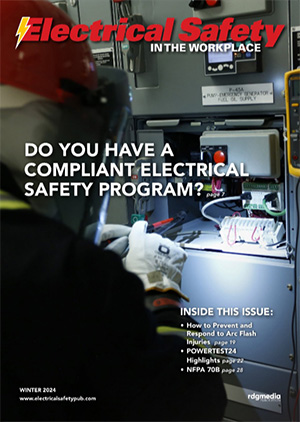NFPA 70E® Training: A Springboard To Greater Safety And Health Performance Excellence
By Colin Duncan, Contributor
 In 2019, the U.S. Bureau of Labor Statistics (BLS) reported 166 workers were killed on the job due to exposure to electricity — the most electrical-related fatalities in the past five years. Many of those events occur during maintenance work and construction. The BLS reports maintenance and repair as one of the most dangerous occupations for serious injuries and fatalities. In 2019, 771 workers received fatal injuries doing this work — almost 15 fatalities every week.
In 2019, the U.S. Bureau of Labor Statistics (BLS) reported 166 workers were killed on the job due to exposure to electricity — the most electrical-related fatalities in the past five years. Many of those events occur during maintenance work and construction. The BLS reports maintenance and repair as one of the most dangerous occupations for serious injuries and fatalities. In 2019, 771 workers received fatal injuries doing this work — almost 15 fatalities every week.
The U.S. is wrestling with reducing serious injuries and fatalities (SIFs) as work fatalities increased 2% in 2019, according to the BLS. SIFs are demanding increased attention to safety in the work environment, with electrical hazards high on the concerns list. Electricity scares people to take action!
Electrical safety webinars draw a thousand registrants or more. Electricians, maintenance personnel, and safety and health professionals who audit their work often form partnerships, a tag-team effort to assess and mitigate the high risks involved. And the National Fire Protection Association’s NFPA 70E® Standard for Electrical Safety in the Workplace® is one of the most closely followed set of safety requirements. NFPA 70E® is a continually evolving document, updated every three years.
NFPA 70E® training is a necessity to safeguard employees from ever-more complex, inter-connected work environments. Training is required for a “qualified person,” described in 70E® as one who demonstrates the necessary skills and knowledge relating to the construction and operation of electrical equipment and installations thereof. Qualified persons must receive training to identify hazards and reduce the associated risk.
The most common electrical hazards in the workplace include overhead power lines, damaged tools and equipment, inadequate wiring, overloaded circuits, exposed electrical parts, improper grounding (the most common OSHA electrical violation), damaged insulation, overuse of ‘temporary’ extensions cord, and wet conditions.
NFPA 70E® sets the bar high for qualified persons. Training requirements are numerous, including:
- The ability to plan jobs safely, identify electrical hazards, assess the associated risk, and select appropriate risk control methods.
- Identify the correct personal protective equipment (PPE) and demonstrate the proper application of PPE.
- Identify and demonstrate the proper use of insulating tools and test equipment.
- Identify the critical elements of the calculation of nominal voltage and conduct the analysis.
- Identify exposed, energized conductors and circuits from other parts of equipment.
- Understand the approach distances and determining risk factors for shock, arc blast, and arc flash boundaries.
Who Needs To Be Trained
Unqualified persons also need to be trained in any electrically related safety practices necessary to keep them out of harm’s way. These are employees who, in the course of work, may interact with electrical equipment. They may be employees using extension cords and portable equipment. For example, a janitor who opens a panel to turn on lights in a facility at the start of the day, or a machinist who starts equipment at the beginning of a shift.
Supervisory managers also need to be trained. They require an executive summary knowledge of NFPA 70E® — not a deep dive into technical specifications — but enough information to effectively audit the practices of qualified and unqualified personnel involving electrical risk.
Unqualified persons do not face the same level of inherent risk as qualified individuals, but it can be difficult for employers to distinguish. Employees may be qualified for some tasks and not others. SEAM Group provides an e-learning module with basic electrical safety concepts and an assessment at the conclusion to score an individual’s training performance and make a recommendation.
- Yes, the person has the requisite knowledge and skills to take a Qualified Person course. Or,
- No, the individual needs more basic training before moving on to the qualified courses.
The NFPA 70E® training population, aside from supervisory management such as safety professionals, consists of technical, hands-on employees who typically learn procedures and practices by doing the work versus listening to a lecture. And that work can be different at every worksite. Employers often want customized training for their panels and equipment, PPE, and terminology. Some employers want training to a higher standard than required by 70E®, and this training can be customized for customer specific needs.
Targeting training for qualified employees to the level required is one of the most challenging aspects of NFPA 70E® training. A company can have qualified personel doing completely different kinds of work. Some are qualified to work with heavy equipment, others qualified only for maintenance, while others are qualified for troubleshooting.
Perhaps the most common question regarding 70E® training regards the scope of a qualified person’s work. Employers ask: “Is Larry qualified to do this? He’s qualified for some tasks; how do we assess if he’s qualified for other work?”
Consulting and Training providers such as SEAM Group help companies organize around assessing their training needs, scoping, customizing, and delivering the training courses. Large, mature corporations with best-in-class safety and health management systems and internal training departments have their finger on the pulse, and they understand 70E® definitions and requirements. They often use a third-party to handle training capacity.
The Changing Workforce
In booming industries, such as online retailing and express delivery services, on-boarding safety training is overwhelming internal training departments due to frenetic hiring brought on by the pandemic.
In contrast, small businesses may grow beyond what was once perhaps efficient “old school” safety training, where a veteran of 20 years would show a new hire the ropes. They now contract with outside training providers to modernize training methods.
Changing demographics in the workforce is increasing the need for training. Aging baby boomers are retiring and replaced by new workers who need help following procedures safely supported by the ‘why we do it this way’.
NFPA 70E® training is also triggered by the need for either retraining or additional training. If an employee is transferred or promoted to a new position, additional training is required. Additional training is required for all new hires. Retraining is required every three years as NFPA 70E® is updated. The 2021 edition of 70E® is now in effect, and providers such as the SEAM Group are busy setting up retraining based on 2021 edition requirements.The inclusion of human performance and human error knowledge and skills in the 2018 edition of NFPA 70E® is an example of how NFPA 70E’s® continually evolves.
One requirement, a human performance assessment, is to conduct pre-job briefings before the day’s work begins. Workers huddle together briefly to review all workplace hazards associated with completing the task and identify other variables that may impact a safe completion, such as simultaneous operations, cumulative fatigue, time of day, alertness, staff competency, lighting, noise, etc.
This is a risk assessment that goes beyond ‘electrical hazards’ and identifies exposure associated with the work, procedures to be used, special precautions to be deployed, control of energy sources, required PPE, and planning of any actions to undertake in the event of a change of job circumstances or deviation from the process, i.e., Stop the Job! The emphasis on spotting the hazard, assessing the risk in the context of the task to be completed illustrates how NFPA 70E® training can be a springboard to a broader scope of safety and health program training.
Employers may widen the aperture from regulatory conformity and complementarily integrate force-multiplying programs that integrate hazard spotting programs (understanding hazard types and the job safety analysis process) and observation programs (learning how to observe and spot hazards); important skills sets beyond electrical safety to improve safety and health performance.
Another development is the increasing use of technology tools for training in today’s virtual world. In 2020 due to COVID-19, most of SEAM Group’s training was conducted on a virtual, interactive platform that streamed live video of the instructor to participants and mixes in live polling, real-time results, gamification, chat boxes — as close to a live event as possible, a trend continuing in 2021.
In this genre, we have introduced augmented reality allowing competency-based training and assessment to be completed using interactive wearable technology. Many occupational safety and health experts believe the pandemic has raised the profile of safety and health in organizations, garnering increased credibility, increased the use of technology, and company investments in safety have increased, and there is no turning back. ESW
Colin Duncan is the CEO of SEAM Group. He is responsible for overseeing operations, company vision, and business activities globally. Duncan has been an independent board member and executive working with several leading organizations in the safety services market across human factors, process safety, software, and operational excellence. He was previously CEO of safety consulting firm BST/DEKRA Insight.
Share on Socials!
Arc Flash Analysis: Add a Lucrative Revenue Stream by Offering Arc Flash Services
NFPA 70E® 2021 for Electrical Safety in the Workplace®
Tools to Enhance Safety in High Voltage Areas
Leaders in Electrical Safety
• Aramark
• Bowtie Engineering
• Enespro
• Ericson
• I-Gard Corporation
• IRISS
• KERMEL, INC.
• Lakeland Industries
• MELTRIC Corporation
• National Safety Apparel
• National Technology Transfer
• Oberon
• Saf-T-Gard
• SEAM Group
Subscribe!
Sign up to receive our industry publications for FREE!







